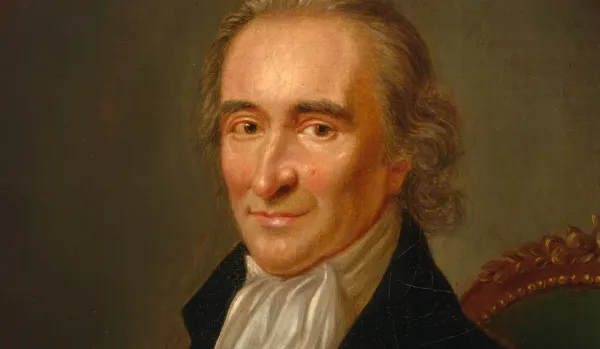The 19th century fascination with daredevils

Note to readers: In yesterday's newsletter, in a post about how Dr. Seuss wrote 'Green Eggs and Ham' on a bet with his publisher, Bennett Cerf, I mentioned parenthetically that Vinton Cerf, one of the inventors of the Ethernet communication standard, was Bennett's nephew. I remembered reading this somewhere, but I should have checked further: Vint debunked this rumor in a reply on Quora. My apologies for the error, which was 100 percent my fault! We now return you to your regularly scheduled programming, which is already in progress:
From Betsy Golden Kellem for The JSTOR Daily: "The so-called Jersey Jumper, a millworker named Sam Patch, became blindingly famous between 1827 and 1829, and for an unusual reason: he liked to jump off high waterfalls for paying crowds. Jumping off river dams or high cliffs was common entertainment for bored New England mill workers, and Patch was determined to make a name for himself taking this sport, as it were, to a new extreme. He survived many jumps, including one from a tall wooden platform into the Niagara River below the famous falls. He died in 1829 at the age of thirty, in an attempt to jump the Genesee Falls in Rochester, New York. He’d made the same jump successfully before, but he didn’t feel it had drawn enough crowds or revenue."
What automobile navigation was like before the GPS came along

Caitlin Dempsey writes for GISLounge: "In the 1920s, the Plus Fours Routefinder made its debut. Worn like a watch, a small map was embedded where the watch dial would normally be found. The maps were wound around small wooden pegs like scrolls and could be switched out of the wristband depending on the route needed. The knobs would be turned to advance the map and directions as needed. The maps were unidirectional. The Baldwin Auto Guide was a scrolled map that attached to the steering wheel. Similar to how film is wound inside a canister, the Auto Guide contained custom map directions which the driver would scroll through by hand. The device even came with a battery operated light for night map reading. An Italian company took this a step further."
Mutant, parasitic impostor queens lurk in ant colonies

From Rebecca Dzombak for the New York Times: "To thrive, ant colonies rely on everyone pulling their weight. For raider ants, this means diligent scouts track down other nests, then direct hundreds of savage foragers to attack. They return with pincers gripping dead young ants to feed the settlement. Clones are produced. But raider ants are among about 50 species plagued by impostors: parasitic ants that resemble queens. They greedily eat the colony’s food, but shirk their own foraging duties, and can only hatch more parasites instead of workers when they reproduce. How the fake queens emerge has long puzzled scientists. A study published Tuesday in Current Biology offers a solution. A 'supergene' that mutates rapidly, between a single generation of raider ants, is likely responsible for the royal impostors."
George Orwell's schooldays weren't as bad as he made them out to be

Sam Leith writes for The Guardian: "Orwell hated his time at prep school – or, at least, seemed to have decided that he hated it by the time he came to recall it in print. To think of his schooldays is, he wrote, was 'to breathe in a whiff of something cold and evil-smelling – a sort of compound of sweaty stockings, dirty towels, faecal smells blowing along corridors, forks with old food between the prongs, neck-of-mutton stew, and the banging doors of the lavatories and the echoing chamber-pots in the dormitories.' Orwell's childhood friend Jacintha Buddicom, however, remembered him as a happy child, and the railing against St. Cyprian's she recalled was warmly humorous rather than bitter or aggrieved. Sports writer Henry Longhurst said that Orwell's hated Mrs Wilkes was 'the outstanding woman of my life,' and when a dinner in her honour was given in 1951, 250 former pupils turned out."
Bats and dolphins evolved echolocation in the same way

Elizabeth Pennisi writes for Science.org: "Dolphins and bats don't have much in common, but they share a superpower: Both hunt their prey by emitting high-pitched sounds and listening for the echoes. Now, a study shows that this ability arose independently in each group of mammals from the same genetic mutations. The work suggests that evolution sometimes arrives at new traits through the same sequence of steps, even in very different animals. The research also implies that this convergent evolution is common—and hidden—within genomes, potentially complicating the task of deciphering some evolutionary relationships between organisms."
Researchers say honeybee venom kills some breast cancer cells

From the BBC: "Australian scientists say the venom from honeybees has been found to destroy aggressive breast cancer cells in a lab setting. The venom - and a compound in it called melittin - were used against two cancer types which are hard to treat: triple-negative and HER2-enriched. The discovery has been described as exciting, but scientists caution that further testing is needed. Bee venom has previously been found to have anti-cancer properties for other types of cancer such as melanoma. The study by the Harry Perkins Institute of Medical Research in Western Australia was published in Nature Precision Oncology."
The vertical forest building in Milan
For some reason (which probably has to do with Twitter's recent changes due to Elon Musk being insane), I can no longer link to Twitter posts and have them appear here, but if you click on this link you will see a video shared by Massimo of the Bosco Verticale or Vertical Forest, a building in Milan with dozens of trees growing on every floor




